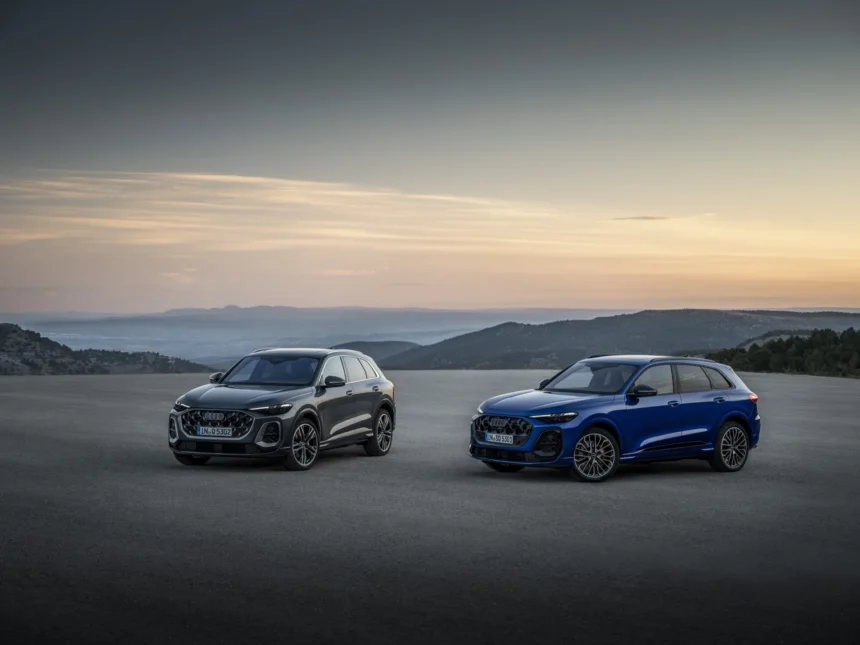Audi is gearing up for an exciting couple of years with plans to launch 20 new models globally, with 15 of those models set to hit North American shores. This intense product launch is fueled by two new platforms – the Premium Platform Combustion (PPC) for vehicles powered by more efficient internal combustion engines, and the Premium Platform Electric (PPE) for the brand’s new battery electric vehicles.
The first wave of this product launch includes the Q6 and SQ6 E-Tron electric SUVs and the S6 E-Tron electric sedan. These models give us a taste of what’s to come in 2025 and 2026. But Audi isn’t stopping there. With EV sales cooling off in the U.S. and uncertain regulatory futures for electric vehicles, Audi is set to launch more plug-in hybrids this year.
One of the most significant changes coming from Audi is a new naming convention for their vehicles. All even-numbered models will be electric vehicles, while odd-numbered models will be powered by combustion engines. This means that the brand’s growing portfolio of electric vehicles will no longer carry the E-Tron tag, simplifying the lineup for consumers.
In addition to this naming change, most 2025 Audi models will come with a three-year navigation trial, a garage door button integrated into the rearview mirror, and some packages with more features. The mandatory destination fee will increase to $1,295, with all prices including that charge.
Some of the new or refreshed Audi models to look out for in 2025 include the Q6 E-Tron electric SUV, the Q5 SUV, and the Q7 three-row SUV. The Q6 E-Tron is the first vehicle to utilize the PPE platform, offering a more efficient and luxurious electric driving experience. The Q5 and Q7 have also been updated with new technology and design elements to keep them competitive in their segments.
Overall, Audi’s aggressive product launch plan and new naming convention show the brand’s commitment to innovation and evolution in the luxury automotive market. With a focus on electric and hybrid technology, Audi is setting the stage for a greener and more sustainable future for their vehicles. The Audi lineup for 2025 is set to impress with a range of new models and updates to existing ones. One of the most exciting additions is the Audi A6 and S6 Sportback E-Tron, which will be the first cars to utilize Volkswagen Group’s new Premium Platform Electric (PPE). These electric models will replace the old combustion A6 and will rival the likes of the Mercedes-Benz EQE, BMW i5, and Tesla Model S. The A6 and S6 Sportback E-Trons will come in three model choices, all featuring all-wheel drive and a 7-speed dual-clutch automatic transmission.
The base model, known as the A6 Sportback E-Tron RWD, will have a 362 hp motor and a 0-60 mph time of 5.2 seconds. The A6 Sportback Quattro will add a second front motor, bringing the total output to 422 hp with a faster 0-60 mph time of 4.3 seconds. The top-of-the-line S6 model will boast an impressive 543 hp and a 0-60 mph time of just 3.7 seconds. All models will feature an 800-volt electric vehicle architecture with DC fast-charging times of 21 minutes from 10-80% state of charge.
In addition to the A6 and S6 Sportback E-Tron, Audi is also updating its flagship electric sedan, the E-Tron GT. The new models will offer more power, more range, and greater efficiency compared to the previous versions. The lineup will include a new 670-hp S E-Tron GT, an RS E-Tron GT with 845 hp, and a top-of-the-range RS E-Tron GT Performance with a staggering 912 hp. All E-Tron GT models will now feature a 105-kWh battery pack and are expected to have a range of around 280 miles.
Other updates in the Audi lineup for 2025 include the A3 compact sedan, which now comes with all-wheel drive standard. The A3 will feature a 2.0-liter turbo-4 engine with 201 hp in the base model, while the S3 will have 328 hp and the RS 3 will boast 401 hp. All models will come with a 7-speed dual-clutch automatic transmission.
As for carryover models, Audi will continue to offer a range of options including the A4 compact sedan, A7 and A8 full-size sedans, Q3 small crossover SUV, Q5 compact crossover SUV, and Q8 five-seat crossover SUV. Pricing for these models will vary depending on the trim level and engine options.
Unfortunately, there will be some models that will be discontinued after 2025, including the Audi A4 sedan, A4 Allroad wagon, S4 sedan, Audi A5 coupe, convertible, and RS versions, and the Audi Q8 E-Tron.
Overall, the 2025 Audi lineup promises to deliver a combination of luxury, performance, and cutting-edge technology for Audi enthusiasts and electric vehicle enthusiasts alike. With a range of new models and updates to existing ones, Audi continues to push the boundaries of innovation in the automotive industry. The world of technology is constantly evolving and expanding, with new advancements and innovations being made every day. From the latest smartphones to cutting-edge artificial intelligence, there is no shortage of exciting developments in the tech industry. One of the most fascinating areas of technological advancement in recent years has been the rise of virtual reality (VR) technology.
Virtual reality refers to a computer-generated environment that simulates a physical presence in the real world or an imagined world, allowing users to interact with their surroundings in a completely immersive way. VR technology has been around for decades, but recent advancements in hardware and software have made it more accessible and realistic than ever before.
One of the key components of virtual reality technology is the headset, which is worn by the user to experience the virtual world. These headsets are equipped with high-resolution displays, motion sensors, and tracking technology that allow users to move and interact with the virtual environment in real-time. Some headsets also include hand controllers, which enable users to manipulate objects and interact with the virtual world in a more tactile way.
In addition to headsets, virtual reality experiences often require specialized software and hardware, such as powerful graphics cards and high-speed internet connections. These components work together to create a seamless and immersive experience for users, allowing them to feel like they are truly present in the virtual world.
Virtual reality technology is being used in a wide range of industries, from gaming and entertainment to healthcare and education. In the gaming industry, VR technology has revolutionized the way players experience their favorite games, allowing them to fully immerse themselves in virtual worlds and interact with characters and environments in new and exciting ways.
In the healthcare industry, virtual reality is being used to train medical professionals and students in complex medical procedures, allowing them to practice in a realistic and risk-free environment. Virtual reality technology is also being used in therapy and rehabilitation, helping patients overcome phobias, PTSD, and physical disabilities through immersive and interactive experiences.
In the field of education, virtual reality technology is being used to enhance learning experiences and engage students in new and innovative ways. Virtual field trips, simulations, and interactive lessons are just a few examples of how VR technology is being used to create more engaging and effective educational experiences for students of all ages.
As virtual reality technology continues to advance and become more widespread, the possibilities for its use are virtually limitless. From entertainment and gaming to healthcare and education, VR technology is revolutionizing the way we interact with the world around us and opening up new opportunities for innovation and creativity. The future of virtual reality is bright, and we can’t wait to see where this exciting technology takes us next.





